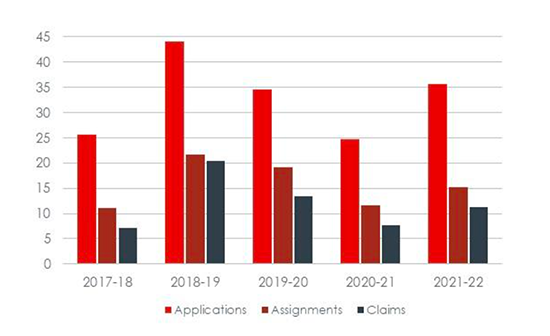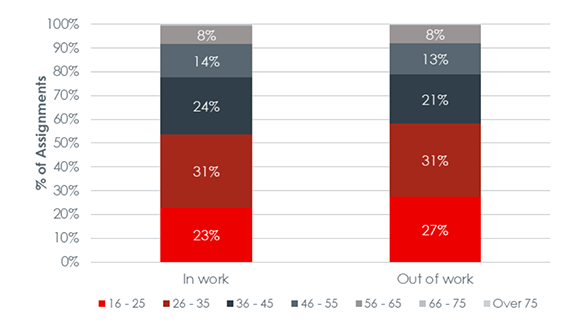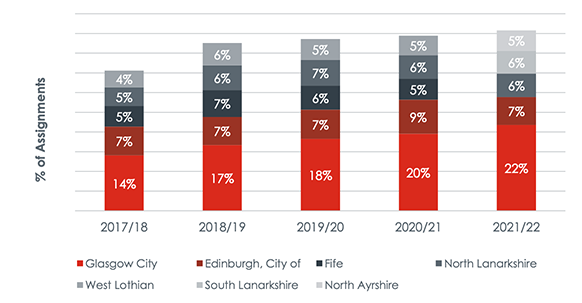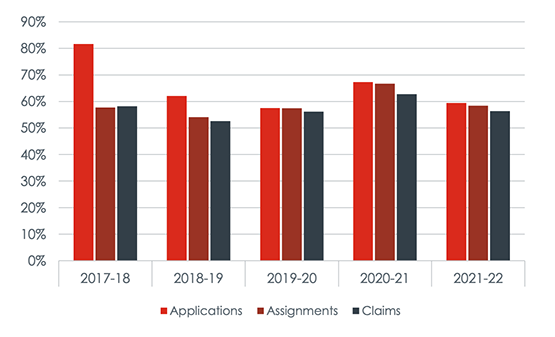Individual Training Accounts: evaluation
An evaluation of the Individual Training Account scheme.
ITA Programme profile
Introduction
This chapter describes the numbers and characteristics of people who apply for, book a course with and use ITAs. It draws on management information gathered by SDS as part of the application and finance processes.
SDS provided data on the ITA programme for the period 2017/18 – 2021/22. Pre-made data tables were shared with SQW, which covered: applications, assignments, claims, total spend and training providers which were broken down by demographics, region, curriculum and work status. Further cross tabs were provided on request. This chapter provides the main headlines from the monitoring data.
Applications, assignments and claims
Figure 2 shows how applications and ITA assignments have changed since the start of the programme. Between 2017/18 – 2021/22, there were a total of 164,280 ITA applications, which resulted in 78,734 ITAs assigned (courses booked) and 59,778 claimed (used)[2]. Numbers of applications and ITAs booked and used peaked in 2018/19, and prior to Covid-19 were beginning to fall. While this may suggest declining interest in the programme, it may also reflect the introduction of new funding sources available to individuals such as the support through Developing the Young Workforce (DYW), No One Left Behind (NOLB) and the Employability Fund (EF).
As expected, applications and ITAs booked and used fell during the pandemic, however the data for 2021/22 suggests both are beginning to recover. Yet, in terms of conversion rates, pre pandemic (2019/20) 39% of applicants became ITA participants and attended a course, whereas in 2021/22 32% of applicants participated in a course suggesting the conversion rate hasn't yet recovered to the same level.

Source: SQW analysis of SDS monitoring information
Demographic Profile
Younger people were more likely to book an ITA course. Those aged 26-35 consistently accounted for almost one-third of all recipients (31%), with those aged 16 – 25 making up around 25% of recipients each year (with a peak in 2018/19 of 29%). People aged 46 and over were less likely to apply for and book an ITA, and this number has been steadily declining since 2017/18 (from 25% to 22%). These patterns were similarly reflected in the applications process.
Younger people booking ITAs were slightly more likely to be out of work. When looking at employment status in 2021/22, young people aged 16-25 made up a slightly larger proportion of those out of work, compared to those in work. On the flip side, those booking ITA aged 36-45 were slightly more likely to be in work (Figure 3).

Source: SQW analysis of SDS monitoring information
Men are more likely than women to book ITAs. This gender split has generally been consistent since 2017/18, with men accounting for between 57% - 61% of ITAs booked each year. During the pandemic in 2020/21 this became more pronounced, with 68% of users being men. Men also appear to be more likely to apply for an ITA, however there is a substantial number of applications where a gender response is not provided so this should be treated with caution.
Women are more likely to be in work while booking an ITA. When looking at employment status in 2021/22, women account for 59% of ITAs booked by those in-work, compared to 25% of out of work. In contrast, men account for 72% of all out of work ITAs booked and 40% of those in-work.
It appears that most ITAs are booked by people of white ethnicity, although bookings from other minority ethnic groups are increasing. This data should be used with some caution as almost one third of those captured in the monitoring information preferred not to state their ethnicity. In 2017/18 71% of those booking an ITA identified as ethnically white, which decreased to 63% by 2021/22. ITA courses booked by those identifying as ethnically Asian, Asian British, Black, Black British/Caribbean or African, or mixed ethnicity grew from 4% to 6% over the same period. People of white ethnicty booking ITAs are slightly more likely to be unemployed, whereas people from other minority ethnic groups are slightly more likely to be in-work.
A small number of ITAs booked are by people who disclose a disability. In 2021/22 6% stated a disability, and this has remained generally consistent since 2017/18. This is also consistent with the level reported during the application process. Again, in applications and course bookings, around one third of people preferred not to answer the monitoring question on disability.
Geographic Profile
Almost a third of ITA courses booked were from people who lived in Glasgow City and the City of Edinburgh, which may be expected given the large population sizes in these two Scottish cities. Figure 4 shows the distribution of ITAs booked by their residential address. This proportion has been increasing each year, from 21% in 2017/2018 to 29% in 2021/22. Local authorities with the next highest levels of ITAs consistently between 2017/18 and 2020/21 include Fife, North Lanarkshire and West Lothian. In 2021/22 South Lanarkshire and North Ayrshire were within the top five local authorities for the first time.
At the application stage, and when training was chosen, there was little difference between local authorities in terms of the percentages of people who were in-work and out of work booking ITAs.

Source: SQW analysis of SDS monitoring information
Employment status
People out of work account for the majority of applications, bookings and claims. Of the 164,280 applications since 2017/18, 64% were made by people out of work. Unemployed people booked 58% of courses, and accounted for 56% of ITAs claimed. However, the gap between those in work and out of work applying and claiming an ITA has been narrowing from 2017/18 (Figure 5).

Source: SQW analysis of SDS monitoring information
Since 2018/19 the percentage of applications resulting in ITA claims made has been relatively flat for people both in and out of work. In 2018/19 47% of people in work and 53% of people out of work applied and claimed their ITA. By 2021/22 these proportions had remained stable at 44% and 56% respectively.
Training course choice
ITAs were most often booked for Construction, and Fitness, Health and Beauty courses. This follows the same trend in the numbers of applications. There were 4,524 ITAs booked in Construction and 2,294 in Fitness, Health and Beauty in 2021/22, which represented 30% and of 15% respectively of all ITAs that year.
Since 2017/18 Construction has accounted for the highest level of ITA courses booked, and this has been particularly driven by high numbers of people out of work. Over a third of Construction ITA courses booked in 2021/22 (36%) were also young people aged 16 – 25.
Over the same period (except 2020/21), Fitness, Health and Beauty accounted for the second highest level of ITAs and people on these courses were more likely to be work and more likely to be aged 26 - 35 (Table 1).
| 2019/20 | 2019/20 | 2020/21 | 2020/21 | 2021/22 | 2021/22 | |
|---|---|---|---|---|---|---|
| In Work | Out of Work | In Work | Out of Work | In Work | Out of Work | |
| Construction | 7% | 45% | 11% | 54% | 8% | 45% |
| Fitness, Health and Beauty | 27% | 9% | 12% | 4% | 20% | 11% |
| Security | 7% | 12% | 4% | 6% | 6% | 9% |
| Health and Safety | 4% | 8% | 7% | 12% | 6% | 11% |
| Hospitality | 10% | 7% | 2% | 1% | 6% | 4% |
| Transport | 13% | 6% | 19% | 8% | 18% | 8% |
| Social Care | 7% | 2% | 16% | 4% | 15% | 2% |
| Total | 100% | 100% | 100% | 100% | 100% | 100% |
Source: SQW analysis of SDS monitoring information
During the pandemic in 2020/21, there were fluctuations in course choices. Fitness, Health and Beauty accounted for relatively low levels of ITAs due to health and beauty being removed as a curriculum temporarily for health and safety reasons. Construction accounted for 40% of all ITA bookings that year (yet, absolute numbers declined from 5,589 in 2019/20 to 4,667 in 2020/21), while Transport became the second most popular curriculum with 12% (1,400) of ITA bookings. People booking ITAs for Social Care courses increased from 736 to 883 in 2020/21, and further increased to 1,126 in 2021/22.
In 2021/22 women were the majority of ITAs bookings in Fitness, Health and Beauty (97%), and Early Years and Childcare (92%), whereas men were the majority ITA bookings in Construction (94%), Transport (93%) and Security (83%). It is worth noting that in IT, women were the largest group of ITA bookings, accounting for 70% in this curriculum, which probably reflects the type of IT activity being provided given the opposite gender pattern in the IT sector. In addition, people booking ITA courses and reporting a disability were more likely to choose training in IT (13%) and Business (10%).
People booking an ITA and identifying as ethnically Asian or Asian British were more likely to train in Transport, making up almost a fifth (19%) of all bookings. Smaller proportions of ITAs booked were more likely in Language (7%) and Security training (6%). Similarly, Black, Black British / Caribbean or African people were more likely to book ITAs for Security training.
Course top up funding
Most people booking ITAs do not top up their course cost above the £200 funding limit. Around three-quarters of people do not top up their course cost. However, the percentage of those choosing to top up has been increasing since 2017/18 from 20% up to 27% in 2021/22, even although the percentage of people booking ITAs while in work has remained stable.
In 2021/22 younger people were slightly more likely to top up. People aged 26 – 35 were the most likely to top up regardless of whether they were in-work or out of work. Surprisingly, young people aged 26 – 35 who were out of work were slightly more likely to top up (32% of those out of work topping up) compared to those of the same age in-work (29%).
In terms of gender, women make up over half of those who choose to top up (52%), perhaps to be expected given they are more likely to book an ITA while in work. Men are much more likely not to top up, making up 63% of those staying within the limit. Linked to this, given the demography which suggests men are more likely to be unemployed when booking ITAs this may be expected if finances are limited.
Asian or Asian British people booking ITAs were also more likely to top up, accounting for 10% of people who topped up in 2021/22. They were the only ethnicity more likely than not to top up.
Repeat users
Most people only book one ITA through the programme. Around 7% of ITA bookings are from people returning to use the programme in two or more years. These numbers may rise as people who have booked a course on the programme once in the last year or two may return at a later point. Indeed, most participants in the focus groups indicated that they would apply for a course using ITAs again.
The focus groups revealed different types of repeat users: refresher courses (renewing / updating qualifications already achieved); related courses (building on the previous course, widening skills base) and unrelated courses (different course to the previous one). Almost all participants appreciated the opportunity to use the ITA programme multiple times.
Training providers also recognised repeat ITA use, mostly for refresher and related courses. Popular courses in which ITAs were used multiple times included CSCS training, beauty therapy, and English as a second language. However, it was also noted by college providers that repeat use wasn't always the most appropriate funding option for some related courses. As people progressed in their chosen area, they would gain access to bursaries and funding through the Student Awards Agency Scotland (SAAS) which would offer more support. This observation shows how ITAs are also being used as a stepping stone in funding options to support people into a place where they are accessing training which is eligible for further funding support.
Contact
Email: Glykeria.Penna@gov.scot
There is a problem
Thanks for your feedback